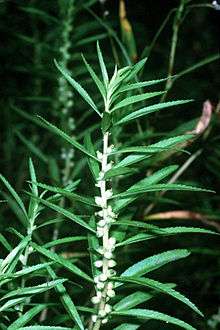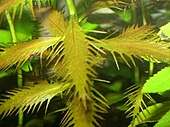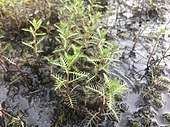Proserpinaca palustris
Proserpinaca palustris, the marsh mermaidweed or common mermaid-weed,[2][3] is a species of flowering plant in the watermilfoil family (Haloragaceae). It is found in North America, the Caribbean, and Central America.[3]
| Proserpinaca palustris | |
|---|---|
 | |
| Scientific classification | |
| Kingdom: | Plantae |
| Clade: | Tracheophytes |
| Clade: | Angiosperms |
| Clade: | Eudicots |
| Order: | Saxifragales |
| Family: | Haloragaceae |
| Genus: | Proserpinaca |
| Species: | P. palustris |
| Binomial name | |
| Proserpinaca palustris | |
Description
It has submerged leaves, which are sessile, 2–6 cm (1–2 in) long. They are deeply divided into linear segments and the emergent leaves are simply serrated. It has fruits with concave sides and sharp or winged angles.[4]
Taxonomy
There are two know varieties; P. palustris var. palustris - which has fruits 4-6mm wide, angles wing margined, very rare SE and NW P. palustris var. crebra (Fernald and Griscom) - which has fruits 2-4mm wide, angles not winged, occasional E and NW [4]
Gallery
 Leaves
Leaves Habit
Habit
gollark: So you could probably do it with an Ethernet cable between them, but I don't know how to configure that, look at bridging the interfaces or something.
gollark: How is your laptop connected to the interweb?
gollark: It sounds like what you really want is threads.
gollark: Amazing.
gollark: Maybe someone actually *has* been insane enough to make GCC able to compile to LLVM, who knows.
References
- "Proserpinaca palustris". ipni.org. International Plant Names Index. Retrieved 2018-09-27.
- "Proserpinaca palustris L.". Natural Resources Conservation Service PLANTS Database. USDA. Retrieved 2018-09-27.
- Weakley, Alan S. (2018), Flora of the Southern and Mid-Atlantic States, working draft of 20 August 2018, University of North Carolina Herbarium, North Carolina Botanical Garden, University of North Carolina at Chapel Hill
- Ann Fowler Rhoads and Timothy A. Block The Plants of Pennsylvania: An Illustrated Manual, p. 494, at Google Books
This article is issued from Wikipedia. The text is licensed under Creative Commons - Attribution - Sharealike. Additional terms may apply for the media files.